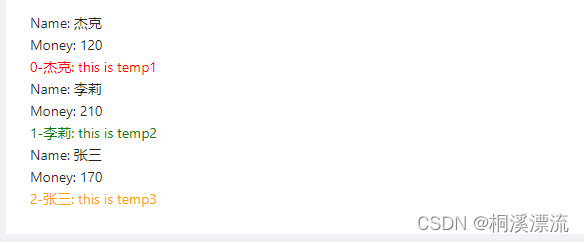JavaScript
angular内容投影详解
发布时间:2022-04-16 发布网站:脚本宝典
脚本宝典收集整理的这篇文章主要介绍了angular内容投影详解,脚本宝典觉得挺不错的,现在分享给大家,也给大家做个参考。
单内容投影
利用ng-content来实现
<!-- 组件 - app-content-single --> <div> <h2>标题</h2> <!-- 投影内容显示位置 --> <ng-content></ng-content> </div> <!-- 使用 --> <app-content-single> <div>this is content</div> </app-content-single>
多内容投影
利用ng-content来实现
<!-- 组件 - app-content-more --> <div> <h3>Herder TITle</h3> <ng-content select=".header"></ng-content> <h3>Body Title</h3> <ng-content select="[body]"></ng-content> <h3>Default Title</h3> <ng-content></ng-content> <h3>Footer Title</h3> <ng-content select="footer"></ng-content> </div> <!-- 使用 --> <app-content-more> <div>this is default01</div> <div class="header">this is header</div> <div>this is default02</div> <div body>this is body</div> <div>this is default03</div> <footer>this is footer</footer> <div>this is default04</div> </app-content-more>
有条件的内容投影-ng-template, ng-container, directive 等来配合实现
单个条件的内容投影
eg: 假设现在有一个人员列表,当某个人的money大于200的时候,额外添加组件中模板定义的内容
定义一个 appChildRef 指令来配合 ng-template 获取模板
import { Directive, TemplateRef } From '@Angular/core';
@Directive({
selector: '[appChildRef]'
})
export class ChildRefDirective {
constructor(public templateRef: TemplateRef<any>) { }
}
app-PErsons - htML
<div class="list-item" *ngFor="let person of persons;"> <div>Name: {{ person.name }}</div> <div>;money: {{ person.money }}</div> <div *ngIf="person.money > 200"> <ng-container *ngIf="childRef" [ngTemplateOutlet]="childRef.templateRef"></ng-container> </div> </div>
app-persons - ts
import { component, ContentChild, OnInit } from '@angular/core';
import { ChildRefDirective } from '../../../../directives/child-ref.directive';
@Component({
selector: 'app-persons',
templateUrl: './persons.COMponent.html',
styleUrls: ['./persons.component.scss']
})
export class PersonsComponent implements OnInit {
persons: { name: string; money: number; }[] = [
{ name: '杰克', money: 120 },
{ name: '李莉', money: 210 },
{ name: '张三', money: 170 },
];
@ContentChild(ChildRefDirective, { static: true }) childRef!: ChildRefDirective;
constructor() { }
ngOnInit(): void { }
}
使用
<app-persons>
<ng-template appChildRef>
<div style="font-Size: 14px; color: red;">this is child ref content</div>
</ng-template>
</app-persons>
效果图

多个条件内容投影
eg: 现在希望通过 persons 数据中的字段进行绑定内嵌的模板来显示
appChildRef 调整
import { Directive, Input, TemplateRef } from '@angular/core';
@Directive({
selector: '[appChildRef]'
})
export class ChildRefDirective {
// 接受定义模板名称-通过这个名称和 persons 中的render字段对应进行显示对应的模板内容
@Input() appChildRef!: string;
constructor(public templateRef: TemplateRef<any>) { }
}
app-persons - html
<div class="list-item" *ngFor="let person of persons;let i=index;">
<div>Name: {{ person.name }}</div>
<div>Money: {{ person.money }}</div>
<!-- <div *ngIf="person.money > 200">
<ng-container *ngIf="childRef" [ngTemplateOutlet]="childRef.templateRef"></ng-container>
</div> -->
<div *ngIf="person.render && temPRefs[person.render]">
<!-- 配合 ngTemplateOutlet 指令给template传递当前person的数据 -->
<ng-container *ngTemplateOutlet="tempRefs[person.render].templateRef; context: { $implicit: person, i: i }"></ng-container>
</div>
</div>
app-persons - ts
import { Component, ContentChild, ContentChildren, OnInit, QueryList } from '@angular/core';
import { ChildRefDirective } from '../../../../directives/child-ref.directive';
@Component({
selector: 'app-form-unit',
templateUrl: './form-unit.component.html',
styleUrls: ['./form-unit.component.scss']
})
export class FormUnitComponent implements OnInit {
persons: { name: string; money: number; render?: string; }[] = [
{ name: '杰克', money: 120, render: 'temp1' },
{ name: '李莉', money: 210, render: 'temp2' },
{ name: '张三', money: 170, render: 'temP3' },
];
// @ContentChild(ChildRefDirective, { static: true }) childRef!: ChildRefDirective;
@ContentChildren(ChildRefDirective) childrenRef!: QueryList<ChildRefDirective>;
get tempRefs() {
const aObj: any = {};
this.childrenRef.foreach(template => {
const key: string = template.appChildRef;
aObj[key] = template;
})
return aObj;
}
constructor() { }
ngOnInit(): void { }
}
使用
<app-persons>
<ng-template appChildRef="temp1" let-person let-index="i">
<div style="font-size: 14px; color: red;">{{index}}-{{person.name}}: this is temp1</div>
</ng-template>
<ng-template appChildRef="temp2" let-person let-index="i">
<div style="font-size: 14px; color: green;">{{index}}-{{person.name}}: this is temp2</div>
</ng-template>
<ng-template appChildRef="temp3" let-person let-index="i">
<div style="font-size: 14px; color: orange;">{{index}}-{{person.name}}: this is temp3</div>
</ng-template>
</app-persons>
效果图

总结
本篇文章就到这里了,希望能够给你带来帮助,也希望您能够多多关注脚本宝典的更多内容!
@H_126_167@ 您可能感兴趣的文章:脚本宝典总结
以上是脚本宝典为你收集整理的angular内容投影详解全部内容,希望文章能够帮你解决angular内容投影详解所遇到的问题。
本图文内容来源于网友网络收集整理提供,作为学习参考使用,版权属于原作者。
如您有任何意见或建议可联系处理。小编QQ:384754419,请注明来意。
猜你在找的JavaScript相关文章
- html font标签如何设置字体大小?html font标签属性用法介绍 2022-05-16
- vue3+TypeScript+vue-router的使用方法 2022-04-16
- vue3获取当前路由地址 2022-04-16
- 如何利用React实现图片识别App 2022-04-16
- JavaScript展开运算符和剩余运算符的区别详解 2022-04-16
- 微信小程序中使用vant框架的具体步骤 2022-04-16
- Vue elementUI表单嵌套表格并对每行进行校验详解 2022-04-16
- 如何利用Typescript封装本地存储 2022-04-16
- 微信小程序中wxs文件的一些妙用分享 2022-04-16
- JavaScript的Set数据结构详解 2022-04-16
全站导航更多
html5HTML/XhtmlCSSXML/XSLTDreamweaver教程Frontpage教程心得技巧JavaScriptASP.NETPHP编程正则表达式AJAX相关ASP编程JSP编程编程10000问CSS/HTMLFlexvbsDOS/BAThtahtcpythonperl游戏相关VBA远程脚本ColdFusionMsSqlMysqlmariadboracleDB2mssql2008mssql2005SQLitePostgreSQLMongoDB星外虚拟主机华众虚拟主机Linuxwin服务器FTP服务器DNS服务器Tomcatnginxzabbix云和虚拟化bios系统安装系统系统进程Windows系列LINUXRedHat/CentosUbuntu/DebianFedoraSolaris红旗Linux建站经验微信营销网站优化网站策划网络赚钱网络创业站长故事alexa域名photoshop教程摄影教程Fireworks教程CorelDraw教程Illustrator教程Painter教程Freehand教程IndesignSketch笔记本主板内存CPU存储显卡显示器光存储鼠标键盘平板电脑安全教程杀毒防毒安全设置病毒查杀脚本攻防入侵防御工具使用业界动态Exploit漏洞分析
最新JavaScript教程
- html font标签如何设置字体大小?html font标签属性用法介绍
- html中的document对象是什么?一篇文章让你了解document对象
- xhtml与html之间有什么区别?xhtml与html之间的异同分析
- HTML <a> download属性使用方法详解
- html中b标签和strong标签的区别是什么?b和strong区别的总结
- html下拉菜单怎么做?html下拉菜单的代码实例介绍
- html单选按钮默认选中怎么做?input标签的单选按钮用法实例
- html文本域标签属性有哪些?html文本域标签属性用法介绍
- html图片怎么等比例缩放?html img图片缩放方法总结(附实例)
- html中col标签中的汉字如何居中?html col标签的基本使用(内有实例)
热门JavaScript教程
- html font标签如何设置字体大小?html font标签属性用法介绍
- html中的document对象是什么?一篇文章让你了解document对象
- xhtml与html之间有什么区别?xhtml与html之间的异同分析
- HTML <a> download属性使用方法详解
- html中b标签和strong标签的区别是什么?b和strong区别的总结
- html下拉菜单怎么做?html下拉菜单的代码实例介绍
- html单选按钮默认选中怎么做?input标签的单选按钮用法实例
- html文本域标签属性有哪些?html文本域标签属性用法介绍
- html图片怎么等比例缩放?html img图片缩放方法总结(附实例)
- html中col标签中的汉字如何居中?html col标签的基本使用(内有实例)